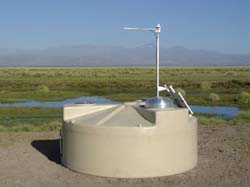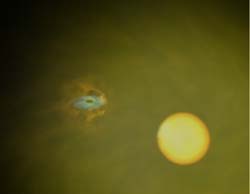Physics and Astronomy
This area deals with the fundamental laws and building blocks of nature and how they interact, the properties and the behavior of matter, and research into space and time and their structures.
innovations-report provides in-depth reports and articles on subjects such as astrophysics, laser technologies, nuclear, quantum, particle and solid-state physics, nanotechnologies, planetary research and findings (Mars, Venus) and developments related to the Hubble Telescope.

Let Gravity Assist You…
’Fly-bys’, or ’gravity assist’ manoeuvres, are now a standard part of spaceflight and are used by almost all ESA interplanetary missions.
Imagine if every time you drove by a city, your car mysteriously picked up speed or slowed down. Substitute a spacecraft and a planet for the car and the city, and this is called a ’gravity assist’. These manoeuvres take advantage of the fact that the gravitational attraction of the planets can be used to change the tra

World’s Largest Air Shower Array Now On Track Of Super-High-Energy Cosmic Rays
Pierre Auger Observatory seeks source of highest-energy extra-terrestrial particles
With the completion of its hundredth surface detector, the Pierre Auger Observatory, under construction in Argentina, this week became the largest cosmic-ray air shower array in the world. Managed by scientists at the Department of Energy’s Fermi National Accelerator Laboratory, the Pierre Auger project so far encompasses a 70-square-mile array of detectors that are tracking the most violent-and perha

ESA’s Integral discovers hidden black holes
Integral, ESA’s powerful gamma-ray space telescope, has discovered what seems to be a new class of astronomical objects.
These are binary systems, probably including a black hole or a neutron star, embedded in a thick cocoon of cold gas. They have remained invisible so far to all other telescopes. Integral was launched one year ago to study the most energetic phenomena in the universe.
Integral detected the first of these objects, called IGRJ16318-4848, on 29 January 2003. Al

Light and nano: quantum mechanics vs. classical optics
Rice physicists show that quantum methods can predict nanophotonic behavior
According to new research from Rice University, scientists studying the way light interacts with metallic nanostructures should throw out their old optics textbooks and bone up on their quantum mechanics instead.
The new findings, which are described in the Oct. 17 issue of the journal Science, offer a new understanding of plasmonics, an emerging field of optics aimed at the study of light at the nan

Duke experiments validate relativity theory’s light speed limit
Addressing a controversy first raised around 1910, two physicists have performed experiments with the aid of an engineer that validate anew the special theory of relativity’s limitations on the speed of light.
In a paper published in the Oct. 16 issue of the research journal “Nature,” the three researchers — Daniel Gauthier and Michael Stenner of Duke University and Mark Neifeld of the University of Arizona -– reached their findings by applying information theory to experiments with la

Grid Technology helps Astronomers keep pace with the Universe
“Intelligent Agent” computer programs are roaming the Internet and watching the skies. It may sound like science fiction, but these programs, using Grid computing technology, will help astronomers detect some of the most dramatic events in the universe, such as massive supernova explosions. The Agents, created by the “eScience Telescopes for Astronomical Research” (eSTAR) project, have been deployed on the United Kingdom Infrared Telescope (UKIRT) in Hawaii. The work is being announced at a conferenc